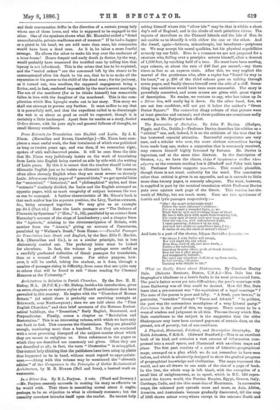A Physical, Historical, Political, and Descriptive Geography. By Keith Johnston,
F.R.G.S. (Edward Stanford.)—This is an excellent book of its kind, and contains a vast amount of information com- pressed into a small space, and illustrated with excellent maps and plans. The first part consists of a series of historico-goographioal maps, arranged on a plan which we do not remember to have seen before, and which is admirably designed to show the gradual progress of geographical knowledge and civilisation. The maps represent the world, and are all drawn to one scale of the size of a page of book. In the first, the whole map is left blank, with the exception of a small blot of enlightenment, so to speak, which in B.C. 450 repre- sented the known world, the Persian Empire, Egypt, Greece, Italy, Carthage, Cadiz, and the thin coast-line of Mauritania. In successive maps, the coloured part spreads more and more, as Asia, Africa, America, and Australasia become gradually discovered, till the map of 1885 shows colour everywhere except in the extreme North and
South, representing the nnpenetrated regions of the Arctic and Antarctic zones; though it is noticeable what a large proportion these undiscovered darknesses bear even now to the known and coloured regions. The centr,11 part of the book is taken up with general physical geography, with clear and accurate accounts of the chief physical facts, and, so far as known, their causes. The third part consists of detailed geographical and historical descriptions of the various continents and states, in detail with the latest information as to political and other facts. The work is extremely well done, and in a most handy form, and is well fitted to become the standard text-book for schools.















































 Previous page
Previous page